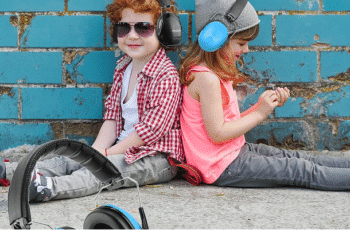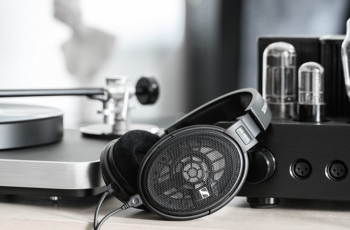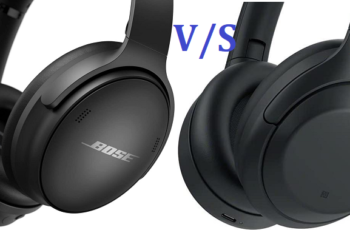The effects of headphones’ treble and bass, The audio quality of listening to music via headphones depends on a number of things. Many subjective and objective considerations are included here.
To begin, we use a purely subjective criterion: personal musical tastes. There are some who like music with a lot of low ends, while others may prefer a more upbeat v-shaped sound. Second, the frequency spectrum is what determines the sound quality (or precision).
This article will explain everything to do with frequency, from its effect on your headphones to how it contributes to audio quality. Presence, brightness, and timbre are all radiated from the tonal region.
You may also like:
Can You Explain the Concept of Sound Frequency?
The vibrating of air molecules produces audible sounds. The ear’s membranes shake when a sound wave hits them, enabling you to hear it clearly. But of course, there’s a lot more science involved than that.
There are five components that make up a sound wave.
- Periodicity of Wavelength
- Amplitude \sFrequency \sSpeed
The speed with which sound waves travel is directly related to the pitch they produce. The sound’s pitch increases as its oscillating waves increase in frequency. This is where the bass and treble frequencies become important.
Treble
Treble refers to the higher-pitched, higher-frequency vibrations. Treble tones, located in the upper range of human hearing, have a more ‘bright’ quality to them. Treble refers, in technical parlance, to frequencies above 6kHz (6000 oscillations per second).
For a more vibrant and vivid listening experience, bump up the treble on your headphones. If you lower the volume, the tunes will take on a more relaxed tone.
Bass
The bass is the antithesis of the treble, as one would expect. Low-frequency bass notes may range from about 80Hz all the way up to 256Hz (256 oscillations per second). The “boom” or “rumble” you experience is the bass doing its thing.
The volume of your headphones’ bass will determine how sensitive they are. This might make the bass instruments in your song more prominent and increase the overall volume.
If you don’t want to wake up your neighbors or cause any disruptions in the home, remember that the bass is what goes through the floors and walls.
Middle
Each time you play with the high and low frequencies, you’re also affecting the midrange (from 200Hz to 5kHz). The midrange frequencies aid immensely with speech comprehension. When the treble and bass are turned down, the mid-range frequencies are amplified, making it easier to hear people’s voices.
Most headphones will lack a mid-band frequency adjustment since it is less common. Nonetheless, if you place a premium on this, purchasing a high-quality set of headphones might be useful.
Treble Frequency Response Accuracy On Headphones
The 2 kilohertz to 9-kilohertz frequency response is what it is.
When the content relies heavily on high-frequency sounds, like speech or cymbals, or when qualities like radiance, clarity, and lightness are essential.
Parts of a Score:
- Std. Err. Score Distribution of One Hundred Percent
- The treble range, or high-frequency range, is anywhere from 2.5kHz to 20kHz.
Tones in the upper register of a musical scale are the more piercing notes. Sound sources that fall within this range, such as hi-hats, cymbals, sibilance, and the higher harmonics of other instruments, make the sound more vibrant.
The standard error of the treble reproduction is determined by measuring the low-treble, mid-treble, and high-treble frequency response.
Treble Std Err
What it is: The weighted standard error in treble frequency response (2.5kHz-9kHz) relative to a target response that sounds balanced to most people.
Important: Balanced and neutral (reference) treble
Performance.
- Good value: <3.75dB
- Noticeable difference: 0.1dB.
- Ratings
The Treble Range standard Error displays how much the measured Treble response deviates from the goal. It’s computed using an Excel-like STDEV.P function.
As humans are less sensitive to high-treble noises, a perceptual weighting filter is used before Std. Err. Our weighting filter begins at 12kHz and decreases error weight to 1/10th of the baseline weight at 20kHz.
High frequencies are sensitive to location and head/ear shape because of their short wavelengths. Hence, most headphones’ Treble response varies between re-seats on the same head and across heads.
Low-Treble
Definition: Average frequency response over/under-emphasis from 2kHz-5kHz.
Important: This range gives most instruments presence, detail, and articulation. Overemphasis may hurt. Under-emphasis hinders voice and lead instrument comprehension.
- Good value: +/-3dB
- Noticeable difference: 0.1dB
Averaging the low-treble frequency amplitudes yields the value. The final number is compared to our 90 dB goal amplitude.
The headphone’s average low-treble amplitude was 93 dB at +3dB. This parameter measures the headphones’ “amount” of low-treble, not its “accuracy,” as Treble Std. Err does.
A headphone with a negative low-treble value would sound muddy, particularly on voices and leads, since instruments receive their clarity, depth, and articulation from this area. Conversely, a headphone with a positive low-treble value may sound harsh, upfront, and even unpleasant.
The treble value
The average frequency response over/under-emphasis from 5kHz-10kHz.
Sibilance range important. This range brightens voices, cymbals, and lead instruments. Over-emphasis sounds sharp and unpleasant, under-emphasis bland and lispy.
- Good value: +/-3dB
- Noticeable difference: 0.1dB
Similar to low-treble, the treble value is computed by averaging the amplitudes of each treble frequency. The final number is compared to our 90 dB goal amplitude.
The headphone’s average treble amplitude was 93 dB at +3dB. This parameter measures the headphones’ “amount” of treble, not its “accuracy,” as Treble Std. Err does.
Treble provides presence, brightness, and sibilance (S and T sounds). Hence, a negative treble headphone sounds dark and lispy (lacking S and T). Conversely, headphones with positive treble values may sound bright, piercing, and even uncomfortable.
High-Treble
Definition: Average frequency response over/under-emphasis from 10kHz-20kHz.
Important: This range delivers sound brightness and airiness. Under-emphasis sounds lifeless while over-emphasis hisses.
- Good value: +/-3dB
- Noticeable difference: 0.1dB
Like low-treble and treble, high-treble is determined by averaging the amplitudes of each frequency in the area. The final number is compared to our 90 dB goal amplitude.
The headphone’s average high-treble amplitude was 93 dB at +3dB. This figure measures the headphones’ “amount” of high-treble, not their “accuracy,” as Treble Std. Err does.
Like low bass, high treble is largely sensed. High-treble frequencies are quite high, whereas low-bass frequencies are low. Age reduces sensitivity to extremely high frequencies, hence certain faults and variances in this zone may not be heard.
Airiness and brightness originate here. Therefore, a closed-up, lifeless headphone with a negative high-treble value. A high-treble headset may sound hissy and airy. High-treble measurements are sensitive to positioning and head/ear shape.
FAQs: How do treble and bass affect headphones Facts you should know
What should my bass and treble be set at headphones?
For starters, the bass level should be set so that it is just barely audible, as too much bass can muddy the overall sound. The treble level should be set slightly higher than the bass and should be increased until it sounds bright but not harsh.
What does treble do in headphones?
Treble describes the high-range spectrum of frequency response, which spans from 2.5kHz up to 20kHz. The high tones are the sharper sounds you can hear in music. Hi-hats, cymbals, sibilance, and the higher harmonics of other instruments all lie within this spectrum and add brightness to the audio.
Is more bass or treble better?
Treble boosting creates a brighter, more airy sound, and bass boosting adds warmth, thumping, and power. There’s no question that most people prefer bass, and that’s just because lower frequencies are easier to hear.
Can too much bass damage headphones?
Extremely unlikely. Hearing damage is a function both of intensity and duration. Most headphones only produce sound at 100 dB or so. You would need a relatively long time at that volume to produce damage.








